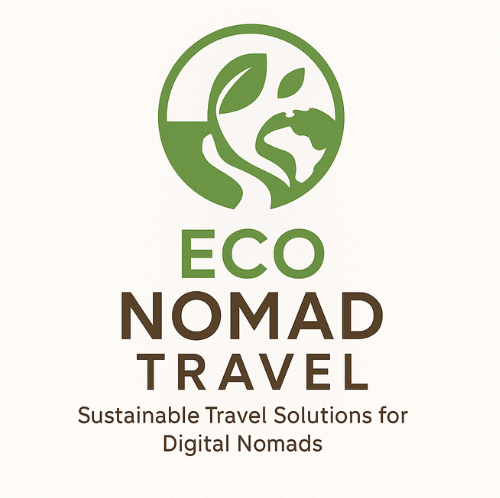VR, AI & Community-Led Planning: How Digital Tools Are Changing Eco Travel in 2025
Technology and sustainability once lived in different worlds — now they’re part of the same journey. As virtual reality tours, AI concierges, and community-led apps reshape how we plan and experience eco travel, 2025 is emerging as the year technology starts to serve not just convenience, but conscience.

A mindful traveler reflects by the sea — balancing technology and sustainability in modern eco travel.
Affiliate Disclosure: This post may contain affiliate links. If you purchase through them, Eco Nomad Travel may earn a small commission — always at no extra cost to you. Our recommendations support low-impact, sustainable exploration.
At sunrise, on a rocky shore overlooking the Aegean, a woman balances her laptop on her knees — not to scroll endlessly, but to explore. She’s previewing an eco-retreat in Patagonia through a virtual reality tour, planning slow-travel routes across Europe with an AI-powered itinerary builder. What would have required a travel agent and weeks of research can now happen in an afternoon — and with fewer emissions. Welcome to the next chapter of responsible travel.
In 2025, virtual reality travel planning and AI concierges are transforming how nomads, families, and eco-conscious travelers experience the world. From Trip.com’s AI itinerary tools to immersive VR eco-tours in Mexico City and Lima, the line between digital exploration and physical adventure is dissolving — and redefining sustainable tourism itself.
How Virtual Reality Is Rewriting Eco Travel Planning
Virtual reality has moved far beyond the novelty of headset demos. In 2025, VR platforms offer immersive “try-before-you-go” experiences that empower travelers to make more sustainable, informed choices. Eco-tourism hubs across Latin America — from Bogotá’s cloud-forest lodges to Lima’s ocean-view eco-resorts — are integrating VR previews that let users explore without the carbon cost of multiple flights.
According to National Geographic, this new model of exploration mirrors the rise of the “virtual concierge,” where artificial intelligence helps design low-impact travel routes and connects travelers with local, community-led projects before they ever arrive. The traveler becomes both informed and intentional.
On Eco Nomad Travel, we’ve long advocated for sustainable travel guides and eco-nomad destinations. VR takes this philosophy further — letting travelers preview the environmental footprint of each experience, visualize transportation alternatives, and even book low-impact stays through ethical booking partners.
AI Itinerary Tools: The Rise of the Conscious Digital Concierge
AI has quietly become the unsung hero of eco travel. In 2025, tools like Trip.com’s AI planner and custom GPT-based itinerary builders let travelers design efficient, eco-conscious routes in seconds. Instead of wasting hours comparing flights, you can ask your AI assistant to create a route with the lowest carbon emissions — combining rail, local transport, and walking-friendly paths.
Need to rent an electric car for part of your trip? Integrate GetRentACar.com to find hybrid or electric models. Want seamless airport transfers? Welcome Pickups provides pre-booked, verified eco-transfer options in over 100 cities.
Beyond convenience, AI itinerary design encourages travelers to think holistically: what’s the cleanest way to move between cities? Which local experiences have a regenerative or educational component? This blend of automation and awareness represents the ideal of mindful modern travel — efficiency without excess.
Plan Smarter, Travel Lighter 🌍
Discover eco-friendly routes, eSIM connectivity, and low-impact transfers — powered by our trusted travel partners.
Airalo eSIM | Yesim eSIM | Aviasales Flights | Trip.com Hotels
Community-Led Platforms and the Social Side of Tech-Driven Travel
Not all travel technology is about algorithms. In 2025, digital communities are shaping how people travel with purpose. Platforms like Nomad List and Fairbnb are creating transparent ecosystems where travelers and hosts collaborate to minimize environmental footprints.
Community-led planning isn’t just an ideal — it’s a measurable force for change. By combining AI route optimization with crowdsourced insights, travelers can identify local conservation programs, workshops, and regenerative projects that welcome volunteers. It’s sustainable tourism with human texture — guided not just by data, but by shared values.
See how this connects with our features on the sustainable digital nomad lifestyle and eco-friendly travel tips to extend your positive impact across continents.
Ethical AI: Data Privacy, Green Computing & the Carbon Cost of Innovation
Even digital tools carry a footprint. AI models, VR platforms, and cloud-based travel planners consume significant energy — but awareness is growing. The leading travel-tech providers in 2025 are investing in renewable data centers and carbon offset programs, ensuring that eco-innovation aligns with its own values.
Travelers should be equally conscious: choose apps and booking tools that disclose sustainability metrics, data usage, and environmental offset policies. Supporting transparency helps push the entire industry toward accountability.
For deeper understanding of low-impact habits, explore our cornerstone guide on low-impact travel habits — where tech and minimalism coexist harmoniously.
Balancing Virtual Planning With Real-World Presence
Ironically, the more immersive technology becomes, the more we crave authenticity. Virtual planning should be a doorway — not a destination. Use VR and AI tools to plan efficiently, then set them aside to experience the real thing: the salt in the air, the laughter of a local guide, the quiet of a forest trail.
Responsible travel in 2025 is about synergy, not separation. Technology should remove friction, not feeling. The ideal eco traveler uses every available digital advantage to deepen — not replace — their connection to nature and culture.
The Human Side of Tech-Driven Eco Travel
How Technology and Human Connection Shape the Future of Eco Travel
While artificial intelligence and virtual reality are reshaping how we plan and experience our adventures, the heart of sustainable travel still begins with human intention. Every new tool — from Trip.com’s AI itinerary planner to immersive VR eco-tours — is only as responsible as the traveler using it. Therefore, understanding when to lean on technology and when to disconnect entirely is essential for creating balance in 2025.
Moreover, as eco-conscious travelers explore the rise of sustainable digital nomad lifestyles, the focus is shifting from quick checklists to mindful planning. For instance, virtual previews of destinations now allow users to evaluate environmental conditions, local conservation efforts, and community engagement before booking. As a result, choosing where to go no longer depends on viral videos — it depends on verified sustainability data and personal alignment with eco values.
Why Empathy and Ethics Matter in AI-Driven Eco Travel
In addition, organizations such as National Geographic Environment and Travel Differently emphasize that technology should enhance empathy, not replace it. By combining machine intelligence with emotional intelligence, travelers can cultivate deeper respect for both people and places. This perspective directly supports the principles of green travel and eco-friendly travel habits, helping digital nomads make informed, ethical choices.
Furthermore, practical tools like Airalo and Yesim eSIMs make connectivity effortless while traveling light, and services such as GetRentACar.com provide energy-efficient vehicle rentals for cross-country exploration. Therefore, travelers can stay connected, mobile, and low-impact simultaneously — something that was far more complicated only a few years ago.
From Data to Decisions: Making Sustainable Choices with AI and VR Tools
Equally important, there is growing awareness that sustainability extends beyond carbon metrics. Ethical travel in the digital age means protecting privacy, respecting local cultures, and ensuring that emerging technology platforms share revenue fairly with communities. For readers interested in deepening this approach, our cornerstone post on sustainable travel outlines step-by-step ways to evaluate tour operators, volunteer opportunities, and eco-certifications before you click “book now.”
Finally, as artificial intelligence continues to evolve, it will inevitably influence how we measure success as travelers. Instead of counting miles flown, future explorers may track how much wisdom they’ve gained or how many ecosystems they’ve helped protect. In this sense, the future of travel tech is not about speed — it’s about sustainability, empathy, and presence. And that’s a transformation every conscious traveler can embrace, both online and on the road.
Author’s Insight — Jeremy Jarvis: For those seeking to rebuild mental focus before embarking on a mindful journey, explore The Power of Clarity — my book on digital detox and presence, designed to help travelers reconnect with awareness before the adventure even begins.
Frequently Asked Questions — Virtual & AI Eco Travel 2025
Understanding Virtual Reality Travel Planning (2025)
1. What is virtual reality travel planning?
It’s the use of immersive VR technology that allows travelers to explore destinations, accommodations, and tours before booking. It helps make better-informed, sustainable travel choices.
2. Can VR really reduce travel emissions?
Yes. VR previews eliminate unnecessary scouting trips, reducing flight-related emissions and making early travel research far more eco-friendly.
3. What’s the best AI itinerary planner for eco travel?
Tools like Trip.com’s AI assistant and Google’s travel planner integrate sustainability data, recommending low-carbon routes and eco-stays automatically.
4. How does AI help reduce travel waste?
AI minimizes duplication by suggesting efficient transport combinations — trains, shared transfers, or walking routes — preventing unnecessary flights and hotel stays.
5. Are AI travel apps secure for personal data?
Reputable platforms now disclose transparent data policies and encryption standards. Always review privacy and sustainability settings before syncing your accounts.
6. What’s the carbon footprint of AI and VR?
AI and VR systems do use energy, but top providers are transitioning to renewable-powered data centers and offsetting emissions through verified programs.
7. Can I preview eco-lodges or trails virtually?
Yes. Many destinations in Mexico City, Bogotá, and Lima now offer VR eco-tours of trails, lodges, and community projects.
Smarter Trips with AI Tools and Sustainable Itineraries
8. What travel tech platforms promote sustainability?
Fairbnb, Trip.com, and Booking.eco integrate verified sustainability metrics, allowing you to filter for green-certified properties.
9. How do AI route planners choose transport?
They compare emissions, time, and cost — recommending routes that use rail or shared transfers over individual flights wherever possible.
10. Are there ethical issues in AI travel planning?
Yes. Data bias and algorithmic exclusivity can occur. Travelers should support transparent, community-led tools that prioritize local participation.
11. Can AI customize travel for accessibility?
Yes. AI assistants increasingly factor in accessibility options — step-free transport, adaptive stays, and inclusive tours — improving equity in travel.
12. What are virtual group trips?
Virtual group trips use shared VR environments so travelers can preview eco-destinations collaboratively, blending social learning with sustainable planning.
13. How do AI chatbots improve sustainability on the road?
They provide real-time energy-saving tips, connect travelers with local co-ops, and even suggest lower-emission transit once you’re on location.
14. Can VR improve cultural awareness before visiting?
Absolutely. Many cultural centers now offer immersive VR experiences that educate visitors on heritage, etiquette, and environmental context.
15. How does this tech help digital nomads?
Nomads can preview coworking hubs, eco-accommodations, and local infrastructure remotely before committing to a destination.
The Future of Tech-Driven Eco Tourism
16. Are there free AI travel tools?
Yes. Google Bard, ChatGPT, and NomadGPT provide free itinerary generation, though premium platforms like Trip.com offer deeper sustainability insights.
17. Will VR replace real-world travel?
No. VR enhances planning but cannot replace sensory, emotional, and cultural connection — it encourages slower, more intentional travel.
18. What’s the role of blockchain in sustainable travel?
Blockchain-based travel records verify carbon offsets and ethical sourcing, ensuring supply-chain transparency for eco-tourism.
19. Can AI track my personal carbon footprint?
Yes. Several apps now provide real-time CO₂ dashboards for your journeys, helping you offset emissions responsibly.
20. How will travel tech evolve by 2030?
Experts expect convergence: AI, AR, and VR will merge into real-time global “travel twins,” simulating destinations dynamically while encouraging fewer, longer, more purposeful trips.
The Rise of Conscious Digital Exploration
As virtual reality travel planning in 2025 continues to evolve, a new generation of travelers is redefining what exploration means. Instead of simply booking flights and hotels, eco-conscious nomads now rely on AI travel assistants to assess environmental impact, cultural authenticity, and digital well-being before ever leaving home. This marks the shift from fast tourism to thoughtful immersion — a change that benefits both people and the planet.
Platforms like Trip.com and Aviasales are integrating predictive AI to recommend flight routes with lower emissions, while sustainable booking networks display verified eco-certifications. Combined with Airalo and Yesim eSIMs for global connectivity, these systems form the backbone of modern low-impact nomadism — travel that is data-driven, transparent, and genuinely sustainable.
Readers inspired by this movement can explore deeper through our guides to sustainable digital nomad destinations and eco-travel places for 2025. Both highlight communities embracing smart infrastructure, slow travel, and technology that respects the Earth’s limits. This fusion of innovation and intention defines the next wave of global mobility — one that values presence over pace.
Ultimately, the future of travel isn’t about having more options — it’s about having better ones. With responsible AI and immersive VR tools leading the way, every itinerary can become a lesson in balance, awareness, and regeneration. That is the true promise of AI-powered eco travel: to make exploration not only smarter, but more human.
Explore More Sustainable Travel Guides
Continue your journey toward mindful, low-impact travel with these featured guides from Eco Nomad Travel. Each article shares practical tips, destination insights, and eco-friendly resources for conscious explorers.
Looking for more? Browse our full collection of sustainable travel stories at EcoNomadTravel.com.

